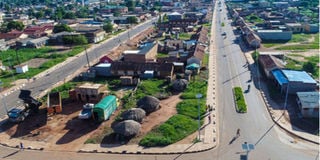Prime
Cabinet approves national physical development plan

An ariel view of Gulu City.
What you need to know:
- The physical development plan is in line with the implementation of the National Physical Planning Act 2010, and the country’s Vision 2040, and provides a holistic strategy for resolving sectoral pressures on land uses amid the country’s growing population.
Cabinet has approved the National Physical Development Plan (NPDP) 2018-2040, which if implemented, will resolve the conflicting sectorial land pressures through proper physical planning and land use development.
The physical development plan is in line with the implementation of the National Physical Planning Act 2010, and the country’s Vision 2040, and provides a holistic strategy for resolving sectoral pressures on land uses amid the country’s growing population.
The plan is now pending parliamentary approval.
The Minister of ICT and National Guidance, Dr Chris Baryomunsi, confirmed the development to the Daily Monitor in an interview yesterday.
“The Ministry of Lands, Housing and Urban Development presented the National Physical Development Plan and we passed it. It is a document that clearly explains how Uganda shall be planned and infrastructure put in place for the next 20 years,” Dr Baryomunsi said.
He added that the plan will, for instance, detail where major road corridors will be placed, railway lines demarcations, and where airports and aerodromes will be constructed.
“The plan will offer that kind of broad frame for the next 20 years so that all developments and constructions are guided by this kind of plan,” he said.
The plan
The plan is based on the projection that the urban population is likely to double from 20 percent to 40 percent of the total Uganda population by 2040.
Under the plan, the National Planning Authority (NPA), ministries, departments and agencies, the private sector, civil society organisations, non-governmental organisations, among other development agencies, will be required to adopt relevant physical factors in their sector development plans for easy implementation.
Dr Baryomunsi emphasised that the government will use a holistic approach to plan for the country.
“We have been having district and sub-region plans but the difference is that we now have a whole macro plan where planning at sub-regional and district level has to fit into this bigger plan.”
After the approval, the Minister of Lands, Housing and Urban Development, Ms Judith Nabakooba, took to her social media Twitter account to thank Cabinet for the job well done.
“Today (Monday), Cabinet led by Ms Jessica Alupo passed the National Physical Development plan 2022/2040. I thank Cabinet and all stakeholders for the support. A big launch will be organised. A new era for smarter urban centres is here,” she posted.
The National Physical Planning Board (NPPB) chairperson, Ms Amanda Ngabirano, welcomed the move.
“We hope Parliament approves it too,” she said.
The plan comes at a time when the NFPB had started scrutinising physical development plans for local governments across the country to assess their standards in accordance with the physical planning principles before they are approved.
More than 40 local government physical development plans have been considered by the board pending approval by regional representation.
Ms Ngabirano also implored Local Government administrations to enter into public-private partnership deals to fund physical development. This comes at a time when local governments are struggling to find funding for their physical development plans.
Mr Mujumbi Yahaya Sulaiman, the Butebo Town Council town clerk, said a physical development plan is a tool without which any urban authority cannot be planned in an orderly way.
The Nakaseke District Chief Administrative Officer, Ms Sarah Aziz, said they want all sub-counties, town councils and municipalities within the district to benefit from the physical planning exercise.




